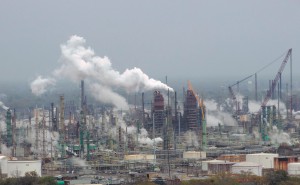Blacks at risk from oil and gas pollution, NAACP study says
4th December 2017 · 0 Comments
By Susan Buchanan
Contributing Writer
Louisiana and Texas have especially large numbers of African Americans living near oil and natural-gas operations, endangering the health of nearly 900,000 people in those two states. That’s according to “Fumes Across the Fence-Line: The Health Impacts of Air Pollution from Oil and Gas Facilities on African American Communities,” co-authored by the Clean Air Task Force and the National Association for the Advancement of Colored People. The study, released in mid-November, was supported by the National Medical Association.
Blacks in Louisiana are at risk from nearby oil refineries, petrochemical plants along the Mississippi River, industry around Lake Charles and hydraulic fracturing or fracking near Shreveport.
During the Obama years, the Environmental Protection Agency took steps to protect residents from pollution. “But the Trump administration has targeted these protections,” and wants to dilute them, the report says. Last year, the EPA issued three final rules that together would curb emissions from new and modified oil-and-gas sources of methane; smog-forming, volatile organic compounds or VOCs; and air pollutants such as benzene.
Federal, ozone-pollution rules took effect this October. The EPA under Trump, however, has proposed suspending rules intended to reduce methane emissions from oil and gas operations. These big sources of methane are responsible for ten percent of the nation’s greenhouse gas emissions, threatening human health and contributing to global warming.
Places with oil refineries and high percentages of minority residents nearby are concentrated along the Gulf—Texas, Louisiana, Alabama and Mississippi, the Fence-Line researchers said. And large numbers of Blacks live near refineries in Michigan and Tennessee.
Toxic emissions travel, but residents next to refineries are most vulnerable to cancer from them, and their risks are even higher if they also live in poverty.
In Baton Rouge, the ExxonMobil Standard Heights plant is one of the biggest refineries in the nation, and it’s part of a company complex in the state capital. Tens of thousands of people live within two miles of the complex, producing gasoline for the U.S. East Coast. Low-income residents of color reside next to these facilities, the Fence-Line researchers said. Forty-five percent of children in the Standard Heights section dwell in poverty. Louisiana’s Department of Environmental Quality permits Exxon’s complex to release millions of pounds of pollution yearly into the air. The city of Baton Rouge is half African-American.
“In 2016, the EPA finally indicated that the air quality in Baton Rouge was compliant with EPA standards,” the Fence-Line researchers said. But leaks and accidents continue at the Exxon facility, and neighbors have reported incidents and unhealthy conditions there this year, according to the nonprofit Louisiana Bucket Brigade in New Orleans.
“African-American exposure to Louisiana’s oil and gas pollution is increasing because our state relentlessly permits these facilities to move in here and expand,” Anne Rolfes, founding director of the Louisiana Bucket Brigade, said last month.
Louisiana is a big natural-gas producer, and gas activities can be a health threat, the Fence-Line researchers said. Among metro areas nationwide, Shreveport-Bossier City, surrounded by gas output from fracking, ranks ninth for adverse, ozone-attributed health effects to African Americans. That ranking was based on asthma attacks and lost school days. Dallas-Fort Worth, also in natural gas territory, has the worst record.
More than 150 petrochemical plants and refineries line the 85-mile “cancer ally” from Baton Rouge to New Orleans. Black communities, many of which were founded in plantation areas after slavery, are at risk in Norco, including the Diamond neighborhood, and St. Rose in St. Charles Parish; LaPlace in St. John the Baptist Parish; Geismar and Donaldsonville in Ascension Parish; towns in St. James Parish; St. Gabriel in Iberville Parish; and Baton Rouge, among other places.
In southwest Louisiana, over a dozen chemical plants and refineries surround Mossville, a Black community in the Lake Charles suburb of Westlake.
Last month, retired Lt. General Russel Honoré, who led relief efforts after Katrina, said Louisiana’s DEQ continues to give permits to plants known to emit pollutants that cause cancer. Plants along the lower Mississippi River threaten the health of Blacks and Whites, he said. “These companies tend not to hire African Americans living next door. Whites living further from the plants get lots of the jobs. But both groups get sick from the chemicals and emissions.”
In particular, Honore pointed to chloroprene emissions from the Denka Performance Elastomer plant in LaPlace as a serious concern. Chloroprene is a byproduct of making neoprene, a rubber used in athletic gear and wet suits.
The EPA says that it’s monitoring the Denka plant with LDEQ and that the facility is required to test emissions and do other monitoring. “EPA has its own authorities and will do what it believes is necessary to protect human health” in the area, the federal agency says about Denka on its website. “We are also working with community leaders and members.” In 2010, EPA’s Integrated Risk Information System assessment identified chloroprene as a likely human carcinogen.
Honore said the Louisiana Tumor Registry, managed by the LSU Health Sciences Center in New Orleans, provides data on cancer clusters. But he said the medical needs of low-income African Americans living near petrochemical plants and refineries often aren’t attended to. “In a typical case, a Black man in his fifties dies, and the hospital says it was pneumonia. But it may have been undiagnosed cancer. His case isn’t recorded in the tumor registry.”
Data in the state’s tumor registry is incomplete, based on “tribal knowledge” or unwritten, known information in Louisiana communities, Honore said.
Honore said LDEQ Secretary Chuck Carr Brown, an African American, has done little to keep Black communities out of harm’s way. But he said the lines of communication with LDEQ have improved under Brown and Governor John Bel Edwards, compared with the Jindal Administration.
Meanwhile, in soil, lead from gasoline and remnants of other oil and gas products remain a threat to African Americans in greater New Orleans, Dr. Howard Mielke at Tulane University School of Medicine’s pharmacology department said last month. Based on his pre-Katrina research, “amounts of lead in the city’s interior were substantially larger than in outlying communities of New Orleans,” he said. The Crescent City was two-thirds Black before Katrina struck in 2005 and is 59 percent Black now.
Bad smells waft across southeast Louisiana day and night, but the EPA says smog is on the wane. “Ozone smog is declining in New Orleans and statewide, due in part to precursor—volatile organic compounds and oxides of nitrogen—emissions going down,” EPA spokeswoman Enesta Jones in Washington said last month. That’s after roughly two decades of stricter, federal air-quality regulations.
Pollutants emitted by cars, power plants, refineries, chemical plants and industrial boilers react in the presence of sunlight, creating ground level or “bad” ozone. Ground level ozone, the main ingredient in smog, is harmful to people and ecosystems.
Fence-Line researchers said much more needs to be done to combat pollution. African American residents should learn about oil and gas facilities in their communities and push to have them decommissioned, the researchers said. They should support technologies that reduce air pollution. And they must urge their leaders to defend the Obama administration’s safeguards and to seek even more government protection from emissions to achieve better health.
This article originally published in the December 4, 2017 print edition of The Louisiana Weekly newspaper.




